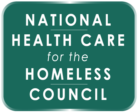For 2021, Shine a Bright Light on the Dark Truth About Homelessness
January 4, 2021
A year-end reflection from Bobby Watts, CEO of the National Health Care for the Homeless Council, and Donald Whitehead Jr., Executive Director of the National Coalition for the Homeless
Thirty years ago, the truth that homelessness is not inevitable led to the first Homeless Persons’ Memorial Day, held each year on December 21 — the first day of winter and the longest night of the year. The observance of Homeless Persons’ Memorial Day, which is now held in more than 100 cities in the U.S. and other nations, began through a partnership of the National Health Care for the Homeless Council and the National Coalition for the Homeless with three objectives: 1) to shine a bright light on the dark truth that homelessness kills; 2) to ensure that those who died are not forgotten; and 3) to mobilize action to end what is often a death sentence — homelessness.
For too many people experiencing homelessness, each commemoration may be their last. Thousands of Americans experiencing homelessness die prematurely and unnecessarily in the world’s richest nation. Communities of color, especially African American and Native American populations, experience homelessness and die at disproportionate rates from this painful and persistent reality. In 2020, Homeless Persons’ Memorial Day was marked by the twin hopes of defeating a worldwide pandemic and achieving a more perfect union in the U.S. with racial justice that is long overdue.
A public policy change from 40 years ago was largely responsible for creating the present-day scale of homelessness — and different public policies can end it. The rise in homelessness coincides with cutting more than three-quarters of the federal funding between 1979 and 1982 that makes housing affordable for poor people. The budget cuts were not a matter of the country not being able to afford the subsidies, but of ideology. We know this because at around the same time, federal subsidies for homeownership — which overwhelmingly go to the wealthy — increased dramatically, to the point where they now are six times greater than rental subsidies for the poor. This shift in priorities proved to be, quite literally, a death sentence for the most vulnerable.
Society measures what society treasures, and that unfortunately does not always include people experiencing homelessness. We do not know the number of people who die without a home because only a few localities conduct a systematic count. Thanks to two cities that do systematically count homeless deaths, we know they have increased substantially. In New York City, homeless deaths grew by more than 50 percent between 2008 and 2018, and in Los Angeles County, homeless deaths doubled between 2014 and 2019. Several organizations have worked together to create a Homeless Mortality Toolkit to encourage and equip more cities and counties to measure the true scope of the problem and to design interventions that work. We should count our neighbors without homes because people without homes count.
Throughout 2020, COVID-19 taught us an indisputable fact: housing is health care. The critical link between housing and health was further underscored when the Centers for Disease Control issued a moratorium on evictions. The moratorium, which had been slated to end on December 31, has been extended until January 31. If the moratorium ends, almost five million households will be at risk of eviction. If that happens, one study estimates these evictions would cause an additional 10,700 excess deaths nationally.
Homeless deaths are not inevitable. The President-Elect is the first in 40 years to propose that funding for affordable housing be available at a level where every qualifying household receives rental subsidies. That means we need to be speaking up. Urge your public officials to end the national shame of homelessness now.
Let the 2020 Homeless Persons’ Memorial Day be our last.
